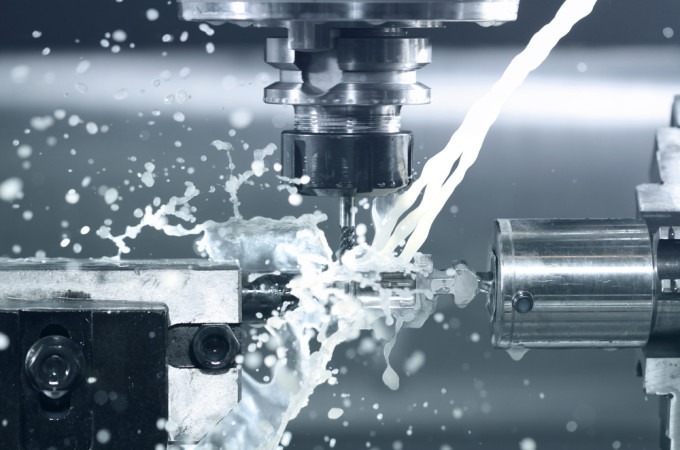Automation in CNC machining is an area that continues to grow and evolve — due in part to technology advances, but even more so, due to the increasing recognition by shop owners of the potential benefits that automation can offer. CNC machining automation, robotics and automated pallet systems for CNC machining can combine to offer a host of improvements in efficiency, capacity, ROI and overall bottom line, all with a minimum of additional effort and manpower required. In fact, that’s the point — automation and robotics give shop owners, entrepreneurs and engineers the opportunity to do much, much more with the same amount of (or even less) work and overall investment.
Before investigating the benefits of CNC machining automation and automated pallet systems, let’s first take a closer look at what exactly we’re referring to with those terms. Automation has been a component of CNC machining nearly since the onset of that technology — it is, after all, a way of automating (and optimizing) work that had previously been done by hand. Today’s CNC automation, however, is highly scalable and able to integrate more seamlessly than ever with other automated systems — which is where automated pallet systems come in.
The ability to automate not only the setup and machining processes themselves, but also the production queue, raw part loading and finished part stacking, is among the chief benefits that illustrate the purpose and function of robotics and automated pallet systems. After some manual setup, these automated systems are able to pick raw stock off a pallet, load it into a machine, complete the necessary — and oftentimes, complex, operation — and stack the finished piece onto a pallet for inspection and fulfillment.
Now that we have an understanding of the core operations of these automation systems, let’s look at some more in-depth benefits that they offer.
Less Idle Spindle Time
Combining CNC machining automation and automated pallet systems can reduce idle spindle time on your machinery almost to zero. Machine automation makes it that much easier to run second- and third-shift operations, and an automated pallet system is one of the best ways to start running a truly lights-out operation. What’s more, automated machining lets you keep running one machine while you or your employees perform setup, maintenance or other functions on other machines. This way, even the idle spindle time that does exist is much more productive.
Better Machinery ROI
Less downtime means that your machines see much more use — which means that you see a return on your investment much more quickly. The decision to invest tens or hundreds of thousands of dollars in new machinery becomes easier when you enact an automation plan that can pay that investment back two or three times more quickly, and the ability to confidently update and upgrade your machinery means better quality and service for your customers — an ultimate benefit for you, as well.
Decreased Setup Time
Robotic-powered automated pallet systems and automated machining mean that if an identical production run is being carried out several times in a row, for a large quantity of pieces, the machine will not have to be set up again for each run — a redundant task that requires a prove out for each successive run, further delaying the productive function of actually making parts. With full automation for identical runs, setup can occur once and be left to run on its own.

Greater Productivity
Not only does your machinery become more productive with automation and robotics, but your workers do as well. Automation allows your equipment to increase output with the same — or even less — amount of manpower required to actually run the machine. With much less time spent on redundant tasks like setup, loading and pallet stacking, your existing personnel is freed for more productive, high-level functions — a great way of driving further innovation and efficiency improvements.
Lower Labor Costs
Automation setup for machining is absolutely an acquired skill. It is, however, less specialized than the skilled jobs, which manufacturers and machine shops have had difficulty filling over the last decade or more. These less specialized jobs enable manufacturers to fill positions at a lower cost than they normally would. The lights-out manufacturing potential of automation also means fewer second- and third-shift workers on the clock, even while production continues at an increased rate. Lower labor costs mean lower overall production costs, which can be passed on to your customers or used to continue to grow your business.

Facilitation of Business Growth
Automation allows shop owners to handle much greater risk in their business practices. Manufacturers can also take a chance on new business expansion opportunities by making a one-time investment in automation machinery to increase capacity, rather than an ongoing investment in a new position that may or may not pan out. An idle machine, while not optimal, is much less expensive than an idle employee. Automation is also of great use for shops that serve volatile industries where business may fluctuate seasonally, or based on greater economic factors. An automated facility makes it easier to scale down production when demand is lower, and scale up greatly when demand is higher, without major personnel or bottom-line adjustments. Essentially, automation gives businesses much greater opportunity to accept jobs that they normally might not, increasing their potential business growth while greatly decreasing the risk.
The Personnel Question
The fear of automation and robotics replacing human workers is a topic that is often discussed. The benefits of automation far outweigh any negative effects, for reasons discussed above — reasons which are worth reiterating. First, automation allows businesses to grow more confidently and remain healthy even in times of uncertainty — an overall benefit to the business and to its employees. Second, automated machining does require human input to run and to run correctly, and there will always be some degree of human involvement no matter the level of automation — if for no other reason than that customers will continue to be likely to prefer, say, in-person QA inspection at some level.
And the intangible factors of your business — your service, your sales pitch, your specialties — still cannot be automated, but automation does give you the chance to give a boost to all of those areas — a chance well worth taking.



